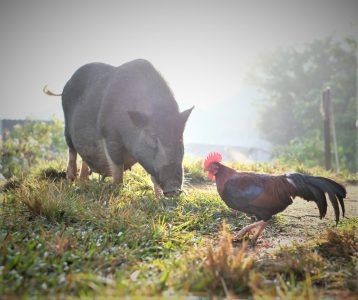Tannins have traditionally been considered as “anti-nutritional” factors in monogastric feeding contrary to how these are viewed and used in ruminant nutrition. This denomination as “anti-nutritional” factors has been associated with their negative effects on:
- feed consumption
- nutrient digestibility
- and productive yield (Butler, 1992, Redondo et al. , 2014).
Therefore, it is almost a common practice within the feed industry to minimize the use of tannin-containing feeds in pig and poultry diets or to take steps to reduce their dietary concentrations when such feeds are used.
The mechanisms for the growth-promoting effects of tannins in monogastric animals are still not that well known as those in ruminants. Although there are some reports indicating that low concentrations of tannins increased feed consumption and thus increased the yield of monogastric animals.
The information which is available up to date, suggests that the growth-promoting action of tannins in monogastric animals is based on the balance between their negative effects on feed palatability and nutrient digestion through protein and enzyme complexes and the beneficial effects associated with their antimicrobial, antioxidant and anti-inflammatory activities. Which enhance the intestinal ecosystem’s health status.
The ultimate impact of tannins on animal performance depends on:
- The type of animals and their physiological state
- Feed
- The type of tannins and their dietary concentrations
This is likely due to a parotid gland hypertrophy and the secretion of proline-rich proteins in their saliva. These type of proteins are capable of binding and neutralizing the toxic effects of tannins (Cappai et al., 2014).
The sources of tannins used in monogastric animal diets are quite limited and only a few of these have been studied thus far. In order to prove their potential as feed additives:
Chestnut tannins
The hydrolyzable tannins of chestnuts (Castanea sativa Mill. ) have recently been evaluated as feed additives for monogastric production animals.
Although in vitro studies showed strong activities against parasites and pathogens residing in the digestive tract of animals (Chung et al., 1998, Athanasiadou et al., 2000, Butter et al., 2001), in vivo evaluations yielded inconsistent results for animal performance.
At concentrations of 0.11% to 0.45% in pig diets, chestnut tannins:
- Improved feed efficiency
- Tended to increase lactobacilli counts within the jejunum
- And reduced cecal concentrations of ammonia, isobutyric and isovaleric acid
But had no effect on:
- Cecal bacterial counts
- Faecal excretion of Salmonella
- Or intestinal colonization(Biagia et al. , 2010).
On the other hand, increasing the concentration from 0.71% to 1.5% reduced feed efficiency, despite the fact that parameters like: feed intake, growth and carcass weight were not affected (Bee et al., 2016).
- Results showed that a chestnut tannin inclusion of up to 0.20% increased daily feed consumption and average daily gain.
- However, a concentration increase of 0.25% appeared to have negative effects, as all the measured parameters were lower.
Chestnut tannin supplementation at 0.45% and 0.5%levels, have also been shown to increase live weight gain and feed consumption in rabbits (Maertens and Štruklec, 2006, Zoccarato et al., 2008).
Grape tannins
Grape seed extracts (Vitis vinifera) and grape pomace contain a significant amount of tannins (Choy et al. , 2014), which have been evaluated for their use as natural additives in monogastric animal feed production.
Choy et al. (2014) reported that adding 1% grape seed extract to pig diets increased the count of Lachnospiraceae, Clostridium, Lactobacillus and Ruminococcaceae in the fecal microbiome.
They found that grape tannin oligomers were only partially metabolized by the gut microbiota, producing phenolic metabolites which tend to be absorbed with greater ease.
- These phenolic compounds may have favored certain bacterial populations, exerting beneficial effects on the colon.
Wang et al. (2008) found that the inclusion of grape seed tannins at a concentration of 5 to 80 mg/kg in broiler diets:
- Significantly decreased fecal excretion of Eimeria tenella
- Improved antioxidant status
- Reduced mortality
- Increased growth yield in broilers infected with E. tenella
Several studies evaluating the effects of grape pomace on pig and poultry yield indicated that the addition of this tannin-rich product at dietary concentrations of up to 10% had no effect on broiler growth performance. However, it did improve broilers’ antioxidant status as well as increasing intestinal populations of beneficial bacteria (Brenes et al. , 2008, Chamorro et al., 2015).
Other tannin sources
Some studies evaluated several other tannin sources for monogastric animals. Iji et al. (2004) reported that the inclusion of mimosa tannin extract (Mimosa pudica) at levels of 0.5%, 1.5%, 2.0%, and 2.5% in broiler diets, reduced feed intake and body weight gain. However, when used at levels below 1.5%,feed efficiency was improved.
Cappai et al. (2014) found that supplementation with acorn-fed tannins (Quercus pubescens Willd.) did not affect feed intake, but it did improve feed efficiency.
Red quebracho tannins (Schinopsis lorentzii) were evaluated for their reduction effects on broiler coccidiosis(Cejas et al. , 2011).
- Increased the body weight gain of challenged birds
- Increased the intestinal crypt:villi ratio
- Reduced oocyst excretion
[/register]
